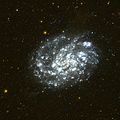NGC 300
| Galaxy NGC 300 |
|
|---|---|

|
|
| Image of the galaxy NGC 300 using the MPG / ESO 2.2 m telescope at the La Silla Observatory | |
| AladinLite | |
| Constellation | sculptor |
|
Position equinox : J2000.0 , epoch : J2000.0 |
|
| Right ascension | 00 h 54 m 53.5 s |
| declination | -37 ° 41 ′ 04 ″ |
| Appearance | |
| Morphological type | SA (s) d |
| Brightness (visual) | 8.1 likes |
| Brightness (B-band) | 8.8 likes |
| Angular expansion | 19 ′ × 12.9 ′ |
| Position angle | 111 ° |
| Surface brightness | 13.9 mag / arcmin² |
| Physical data | |
| Affiliation | Sculptor cluster ?, LGG 4 |
| Redshift | +0.000480 ± 0.000003 |
| Radial velocity | +144 ± 1 km / s |
|
Stroke distance v rad / H 0 |
(5 ± 0) x 10 6 ly (1.38 ± 0.1) Mpc |
| diameter | 70,000 ly |
| history | |
| discovery | James Dunlop |
| Discovery date | August 5, 1826 |
| Catalog names | |
| NGC 300 • PGC 3238 • ESO 295-20 • MCG -06-03-005 • IRAS 00528-3758 • 2MASX J00545347-3741037 • SGC 005232-3757.2 • GC 169 • h 2359 • AM 0052-375 • Dun 530 • HIPASS J0054 -37 • LDCE 0026 NED007 | |
NGC 300 is a galaxy with a pronounced spiral structure (type Sc) in the constellation Sculptor in the southern sky. It has an angular dimension of 19 '× 12.9' and an apparent magnitude of 8.1 mag. It is around 5 million light years away from the Milky Way and, with a diameter of around 45,000 light years, is significantly smaller than our Milky Way with a diameter of around 100,000 light years.
NGC 300 and the irregular galaxy NGC 55 have been considered part of the Sculptor group by many astronomers . The most recent measurements of these galaxies have shown that they are only in the vicinity of this galaxy cluster .
The object was discovered on August 5, 1826 by the Scottish astronomer James Dunlop .
GALEX absorbs ultraviolet light
Infrared image from the Spitzer Space Telescope
In the high-resolution image of the center, individual stars are visible, Hubble space telescope
Web links
- ESO: New distance record for black holes (+ photos & animation) January 27, 2010
- ESO: NGC 300: Portrait of an exemplary spiral galaxy (+ photos, map & animation) September 8, 2010
- Astronews
- GALEX
- Spektrum.de : amateur photo NGC 300
- SIMBAD Astronomical Database




